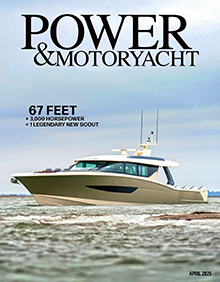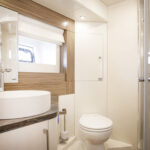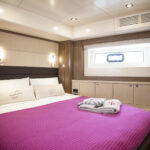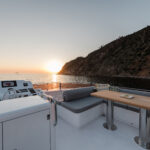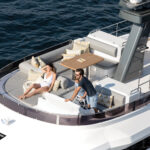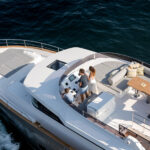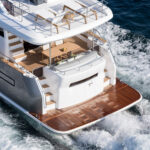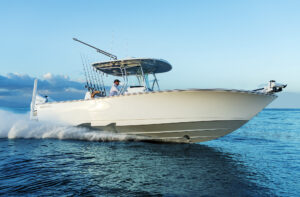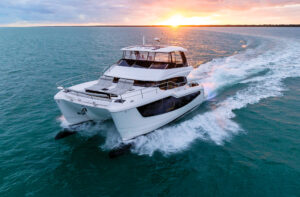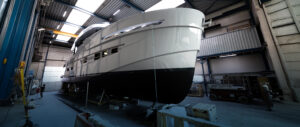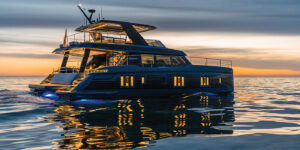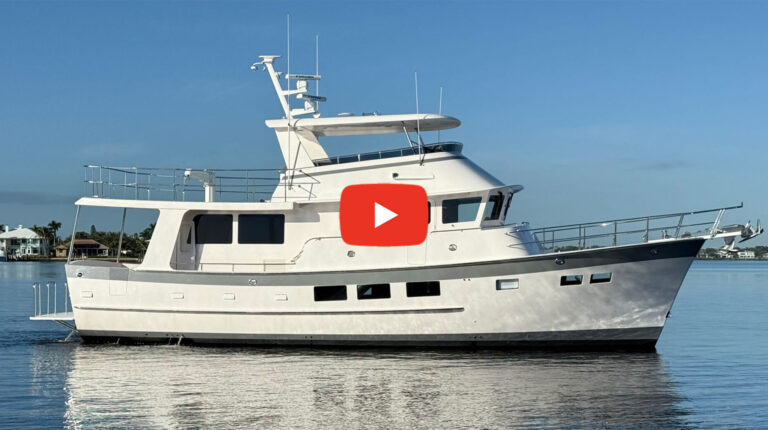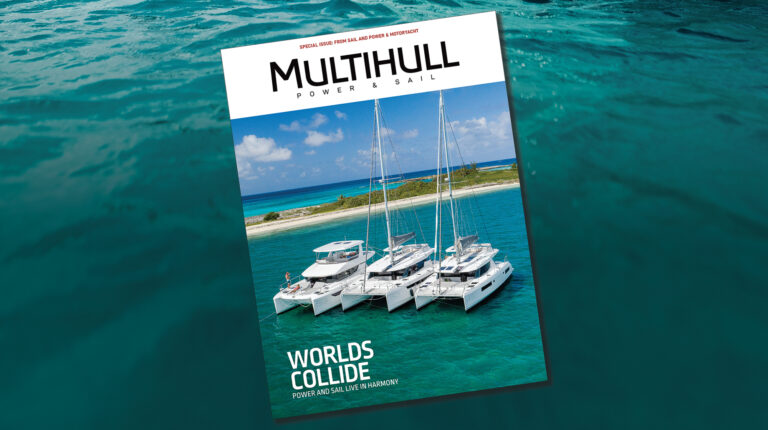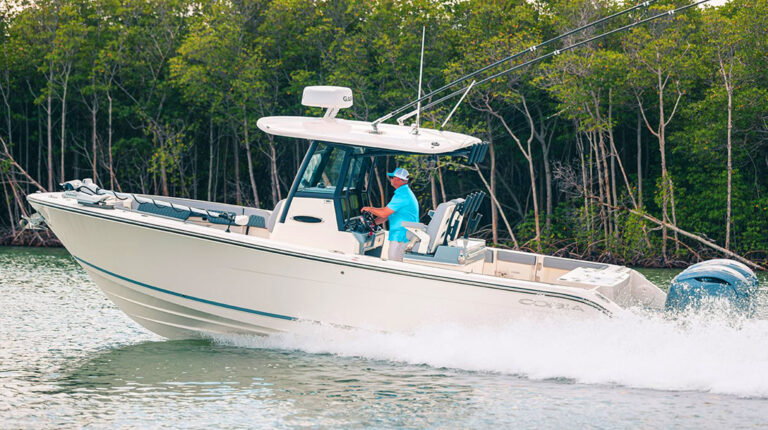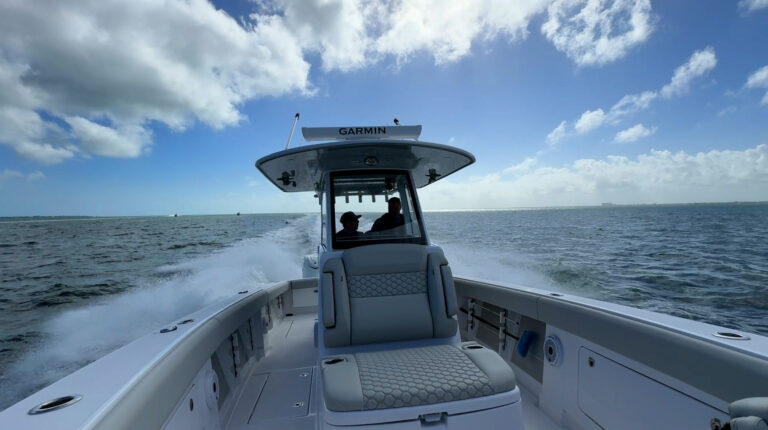Opulent Ottoman
Bursting onto the scene in 2017, Sirena Yachts is attracting worldwide attention. The 58 is poised to keep that momentum rolling.

I must admit I had my doubts. As we were preparing to go to sea, none of the crew had seen fit to stow the flowers that were placed on the shelf just behind the lower helm. This wasn’t some posy in a little fat pot, but a tall glass vase containing a towering bunch of Asiatic lilies. Just as it was hard to miss them, it was hard to imagine them staying upright for very long once we left the harbor. They’re probably secured to the shelf, I said to myself. With the engines warmed and lines cast off, I turned my mind to other things. They must be. Don’t be ridiculous.
This was of course at the Cannes Yachting Festival, where such decorative flourishes are de rigueur and yacht crews have plenty on their minds during sea trials, which are often attended by more people than a boat can comfortably accommodate. In our case I counted some 15 souls, but between the cockpit, the foredeck seating and the capacious flybridge—on a balmy evening, not long before sunset, it was very pleasant to be outdoors—the Sirena 58 managed to provide everyone with a comfortable place to sit.
Sirena Yachts is based in Turkey, part of a larger outfit, which although only 12 years old has already amassed plenty of experience constructing Magellano motoryachts for Azimut, as well as its own sailboat brands. The Sirena 58 follows a 64 which launched the range in 2017. Built using resin infusion with carbon fiber reinforcements, its tall, upright profile and beamy hull promise generous interior volume, and with 6 feet, 7 inches of headroom on the main deck and 6 feet, 5 inches down below, it doesn’t disappoint.
Three layout options are available. In three-cabin boats the choice is basically between a midships or a forward master suite, while in the spacious two-cabin version you would be hard pressed to decide which is the master and which is the VIP.
Our test boat had three cabins with a midships master suite; with its dressing table, sofa, substantial windows and plenty of locker and drawer space, it seemed exceptionally roomy and civilized. (A peek in the machinery space reveled that the engines are mounted fairly well aft on V-drive transmissions, to leave as much volume as possible here). Along with generous stowage space, the VIP forward has its berth set at the comfortable sort of height you might have at home, thanks to the 58’s slab-like topsides forward and near-vertical stem. Here and in the otherwise hard-to-fault twin-berth guest cabin, some owners might find themselves wishing the shower stalls were a little more spacious.

If the Sirena’s comparatively wide beam is key to the comfort of the sleeping accommodations, up on the main deck it is put to equally valuable use. With the galley installed aft, the salon feels exceptionally welcoming, laid out on a single level with an almost 360-degree view. And yet the side decks, sheltered beneath the flybridge overhang and secure behind high bulwarks, are wide, practical and exceptionally seamanlike. There is no hint of compromise.
The pleasantly understated interior decor of the Sirena 58 is by Tommaso Spadolini, whose impressive portfolio includes a number of superyachts, including King Juan Carlos of Spain’s 65-knot Fortuna. Both the 58 and the 64 have naval architecture and exterior styling courtesy of the renowned Buenos Aires studio of German Frers, designers of numerous successful racing sailboats.
The 58 has a moderately round bilge hull form, with a prominent knuckle that runs full-length down each side, pronounced propeller tunnels, a fine entry and a shallow central skeg for directional stability. That vertical bow is very fashionable, of course, and also brings other benefits—a longer waterline to improve low-speed efficiency, as well as greater accommodation volume forward, as we have seen. But it is perhaps a surprising choice for a trawler-style yacht with passagemaking pretensions—fuel capacity is a useful 950 gallons—as it is bound to be less capable of keeping spray down than more traditional forms.

Notwithstanding the shipyard’s description of the hull form as semi-displacement, it is clearly capable of planing: Sirena claims a top speed of 30 knots for the 58 with 840-hp Caterpillar C12.9s, and a cruising speed in the mid-20s. Our yacht was fitted with the smaller 650-hp C8.7s, and its performance was not boosted by the fact that the engines were achieving just 2170 rpm, against their rated maximum of 2300. According to the shipyard the culprit was a season’s worth of hull fouling acquired during the owner’s summer cruise.
At any rate, with just shy of two tons of fuel and water on board, along with a typical Cannes boat show crowd, the top speed we recorded was just 21.6 knots. A yacht of this style is not really about top speed, of course, and at 1800 rpm, cruising along at between 16 and 17 knots, it felt comfortable, confident, manageable and ready to go places.
I did think the helm ergonomics could also do with some refinement. At both stations the throttle levers are uncomfortably far away, and upstairs the helm seat is too low.
A southerly breeze had been keeping the boat show cool all through an otherwise hot and sunny day, and by evening a light swell had built up in the bay. The Sirena’s uncompromisingly fine entry made short shrift of head seas, with very little vertical movement and no slamming, and although I noticed it had a slight tendency to wander when running downwind—most people had found their way upstairs by this time, placing plenty of weight high above the waterline—this was easily corrected on the helm and never a cause for concern. I also found that on their auto setting the trim tabs were holding the bow too far down, which might have affected downwind handling. Some software tweaks should soon sort that out.

With the hull’s modish plumb stem we were not too surprised by the regular packets of spray that doused the few brave mariners on the foredeck, and there were even squeals on the flybridge as we shipped the occasional bigger one over the top. It would certainly keep the windshield wipers busy.
But of course this was a handling trial, at 20-plus knots; on a long cruise, you would probably maintain a more economical speed, and wouldn’t be punching the seas quite so hard, or wearing out the wiper blades quite so fast.
As we came back into the Vieux Port I was picking my way carefully down from the dampened flybridge when I suddenly remembered the flowers. There they still were, standing proudly at attention on their shelf behind the helm station. So obviously they were stuck down. Weren’t they? I checked. They weren’t.
The Test
Test Conditions: Seas: 3-4 ft.
Load: fuel: 390 gal.; water: 166 gal.; 15 people on board.
Sirena 58 — Final Boat Test Numbers:
Speeds are two-way averages recorded via Raymarine GPS. GPH taken via Cat engine display. Sound levels measured at the helm. 65 dB(A) is the level of normal conversation. Range is based on 90% of advertised fuel capacity.
Sirena 58 Specifications:
LOA: 61’0″
Beam: 17’7″
Displ: 61,730 lbs.
Fuel: 950 gal.
Water: 210 gal.
Power: 2/650-hp Caterpillar C 8.7
Price: $1,590,000 incl. shipping, duty, commissioning; ex. sales taxes.
Click here for Sirena’s contact information and index of articles ▶

